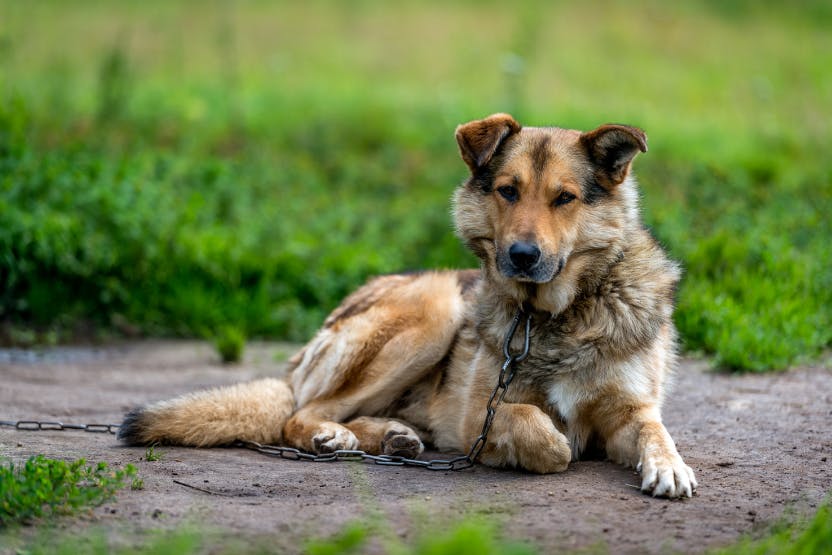The image of a lonely dog tethered outside in the scorching Texas sun pulls at the heartstrings. These animals face a multitude of dangers, from heatstroke to dehydration and entanglement. But what does the law say about chaining dogs outdoors in Texas?
There’s good news! Texas has a law in place to protect dogs from tethering and inadequate shelter. However, there might be some confusion about the specifics of this legislation. This blog aims to clarify the legal requirements for outdoor dog care in Texas and empower you to be a responsible pet owner.
Texas and the Safe Outdoor Dogs Act
Prior to 2022, Texas had limited regulations regarding chaining dogs outdoors. However, with the signing of the Safe Outdoor Dogs Act (Senate Bill 5) in 2021, the state took a significant step forward in protecting animal welfare. The law became effective on January 18, 2022.
The Safe Outdoor Dogs Act focuses on two key aspects of outdoor dog care: tethering restrictions and shelter requirements.
- Tethering Restrictions:
- Gone are the days of chaining or tethering dogs with heavy weights. Improperly fitted collars are also prohibited under the law.
- The one acceptable form of restraint is a leash or tether that allows the dog freedom of movement within a designated area.
- This tether must be at least 10 feet long, or five times the dog’s length from nose to tail, whichever is longer.
- These restrictions are in place to prevent entanglement, strangulation, and restricted movement, which can cause serious injuries or death to chained dogs.
- Shelter Requirements:
- Dogs kept outdoors must have access to adequate shelter to protect them from the harsh Texas elements, including rain, sun, and wind.
- This shelter must be large enough for the dog to comfortably stand, turn around, and lie down.
- It needs a solid roof to provide shade from direct sunlight.
- The floor should be raised to keep the dog dry and clean, away from standing water and waste.
- At least three sides of the shelter must be enclosed to provide protection from wind and other elements.
There are a few exceptions to the law. For example, temporary restraints are allowed during veterinary care or short-term outdoor supervision while the owner is present on the property.
Responsible Dog Ownership in Texas
The Safe Outdoor Dogs Act sets a minimum standard for outdoor dog care. But responsible pet ownership goes beyond just following the law. Here are some additional considerations:
- Exercise and Socialization: Even outdoor dogs need regular exercise and opportunities to socialize with other dogs and humans. A chained dog with limited interaction can become lonely, anxious, and develop behavioral problems.
- Fresh Water: A constant supply of fresh, clean water is crucial for all dogs, regardless of weather conditions. Dehydration is a serious threat, especially in hot Texas summers.
- Temperature Extremes:
- Texas summers can be brutal. Dogs left outdoors are susceptible to heatstroke. Provide ample shade, a cool water source, and access to air conditioning during peak heat hours.
- Winter cold snaps can also be dangerous. Ensure your dog has a well-insulated shelter and comfortable bedding during winter.
- Designe Breeds: Some dog breeds, like huskies or Saint Bernards, may be better suited for outdoor living than others. Research breed-specific needs before acquiring a dog.
Fulfilling Your Pet’s Needs
Dogs are social creatures who crave companionship and interaction. Leaving them chained outdoors for extended periods can deprive them of these essential needs.
Consider alternative solutions if you need to keep your dog outdoors for short periods. A secure fenced yard, a dog run, or tethering with an appropriate leash within a designated area under supervision are all more humane options.
If chaining is the only option due to limitations, rehoming the dog to a more suitable environment where its needs can be met might be the most responsible course of action.
Finding Help and Resources
If you suspect a violation of the Safe Outdoor Dogs Act, you can report it to your local animal control authorities or the Texas Department of Agriculture (TDA). Their phone numbers and websites can be found online.
Several resources are available to pet owners who may need assistance caring for their dogs:
- Local animal shelters: Shelters offer guidance on proper dog care, low-cost or free spay/neuter services, and potential adoption options for those struggling to meet their dog’s needs.
- Rescue organizations: These organizations often specialize in specific breeds and may be able to provide breed-specific advice or foster care for dogs who cannot stay in their current homes.
- Low-cost veterinary care programs: Some organizations or veterinary clinics offer discounted or free veterinary care services for pet owners facing financial limitations.
Conclusion
The Safe Outdoor Dogs Act is a significant step forward in protecting the welfare of dogs in Texas. By understanding the law’s requirements and going beyond the minimum standards, pet owners can ensure their furry companions have a happy and healthy life outdoors.
Remember, responsible pet ownership is about providing your dog with proper shelter, exercise, socialization, and veterinary care. These are not just legal requirements, but expressions of love and compassion for your animal friend.
Learn more about dog care and become an advocate for animal welfare in Texas. Here are some helpful links:
- Texas Department of Agriculture (TDA) Animal Industry Division: https://texasagriculture.gov/
- Texas Animal Control Officers Association (TACOA): https://taca.wildapricot.org/
- The Humane Society of the United States: https://www.humanesociety.org/



